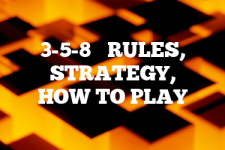Tarot: A Guide to Rules, Playing Instructions & Winning Strategy
Introduction
I’ve always been fascinated by the rich history and strategic depth of the Tarot card game, which has been the topic of many a deep-dive for other writers. Originating in the mid-15th century in various parts of Europe, Tarot was initially a straightforward card game before it became associated with mysticism and divination. The game is played with a unique deck of 78 cards, which includes 21 trump cards, a Fool, and 56 suit cards divided into four suits: Swords, Batons, Cups, and Coins.

I remember the first time I played Tarot. I was at a friend’s house, and we were looking for something different from the usual poker or bridge. My friend brought out a beautifully illustrated Tarot deck, and we spent the rest of the evening learning and playing this intriguing game. It was a night of laughter, intense concentration, and friendly competition that I’ll never forget.
Quick Tip for Tarot
Always remember, the key to winning at Tarot is not just about having high-value cards but also about understanding when to play them.
Rules for playing Tarot
- The game is usually played by three to five players.
- The aim is to win tricks containing valuable cards.
- The player who bids the highest number of points becomes the ‘taker’ and plays against the other players.
- The taker’s objective is to accumulate points equal to or higher than their bid.
The Deal for Tarot
The dealer shuffles the deck and the player to the right of the dealer cuts it. The dealer then distributes the cards clockwise, starting with the player to their left. In a three-player game, each player receives 24 cards, and six cards are placed face-down in the center of the table to form the ‘dog’.
How to Play Tarot
Setup
The player to the dealer’s left leads the first trick. Players must follow suit if possible. If they cannot, they can play any card, including a trump or the Fool.
Gameplay
The player who plays the highest trump or the highest card of the suit led wins the trick and leads the next one. The game continues until all cards have been played.
End of the Game and Scoring
The game ends when all tricks have been played. The taker counts the points in their tricks and the dog. If the total is equal to or higher than the bid, the taker wins; otherwise, the other players win.
Bidding Process in Tarot
The bidding process in a Tarot card game is a crucial part of the gameplay, determining who will be the declarer for that round. This phase of the game involves players competing in a series of bids to establish who has the strongest hand. The player who makes the highest bid becomes the declarer and gets to lead the round. The bid signifies the number of points the player believes they can win in the round. If they fail to achieve their bid, points are deducted from their score. It is a strategy-intensive phase that requires players to evaluate their cards and predict their performance in the game round.
How to Win at Tarot
Winning at Tarot requires a good balance of luck, strategy, and an understanding of your opponents’ gameplay. Keep track of the cards played, especially the high-value ones. Try to control the game by winning tricks when it benefits you and losing when it doesn’t.
Best Strategies for playing Tarot game
- Try to keep a balanced hand with a mix of trumps and suit cards.
- Remember, the Fool can be a powerful card if used strategically.
- Try to force your opponents to play their high-value cards early in the game.
1. Understand the Basics: The first strategy to employ in playing the Tarot game is to understand the basics of the game. This includes knowing the different types of cards, their values, and how the game is played.
2. Familiarize Yourself with the Deck: There are 78 cards in a Tarot deck, each with its unique symbolism and meaning. Familiarize yourself with these cards to increase your chances of making the right decisions during the game.
3. Know When to Bid: In many variations of the Tarot game, players have the option to bid or pass during each round. Knowing when to bid, based on the strength of your hand and the bids of other players, can influence the outcome of the game.
4. Observing Your Opponents: Pay close attention to the cards your opponents are playing and try to deduce what cards they might still have in their hand. This can help you make strategic decisions about what cards to play and when.
5. Play Your Trump Cards Wisely: Trump cards are the most powerful cards in the game. You should try to save these for later in the game when they can have the most impact. However, it’s also important not to hold onto them for too long, as they can be lost if the game ends before you have a chance to use them.
6. Practice Makes Perfect: The more you play, the better you will become. Practice often to improve your understanding of the game and your ability to strategize effectively.
7. Manage Your Hand: It’s important to manage your hand effectively throughout the game. This means playing your cards in a way that maximizes their potential and allows you to maintain control of the game.
8. Understand Scoring: Scoring in Tarot games can be complex, so it’s important to understand how points are awarded and lost. This can influence your strategy and decisions throughout the game.
9. Learn From Your Mistakes: Every game is a learning experience. If you make a mistake or lose a game, try to understand what went wrong and how you can improve in the future.
10. Be Patient: Tarot is a game of strategy and patience. Don’t rush your decisions and take the time to think through each move before you make it.
Variations of Tarot
Tarot has evolved into several variations over time across different cultures, including French Tarot, Austrian Tarot, and Italian Tarot. These variations are primarily distinguished by the number of cards used, with different decks ranging from 78 cards in French Tarot to 54 cards in Austrian Tarot, or even 62 cards in some versions of Italian Tarot. Moreover, these variations also display differences in their scoring systems and bidding processes. For instance, while the French Tarot uses a point-based scoring system, the Austrian version relies on card combinations. Similarly, the bidding process in these versions can range from competitive bidding in French Tarot to more complex systems in the other versions. These variations reflect the rich and diverse cultural interpretations of Tarot across different regions.
Scenarios
One common scenario is finding yourself with a hand full of low-value cards. In this case, try to play your cards in a way that forces your opponents to use their high-value cards, thus increasing your chances of winning later tricks.
Frequently Asked Questions about playing Tarot game
- Can I play Tarot with a standard deck of cards? No, Tarot requires a specific deck of 78 cards.
- Is Tarot a game of luck or strategy? Both. While the deal can influence the game, strategic play is crucial to winning.
- Can I play Tarot with two players? Yes, but the game is best suited for three to five players.
- What is the role of the Fool card? The Fool can be played at any time, regardless of the suit led, and it cannot be won in a trick.
- What happens if the taker does not meet their bid? The other players win, and the taker’s score is reduced.
External Links
Tarot has a pretty fascinating history. If you’re interested in the game from an academic perspective, I can easily recommend Parlett’s excellent Oxford History of Card Games.

Eve Brownlee was a gamer before gaming communities on the internet were a thing. Eve grew up playing traditional, standard deck card games like Rummy and Bezique, taking an interest in the classics Backgammon and Chess. Parlor card games like Bridge continue to keep Eve active in the community. After a long career, primarily in horticulture for USDA in Maryland, Eve now travels and writes on The Pineapple (pineapples.info) and contributes to Quora/Pinterest topics. Contact Eve via email.



